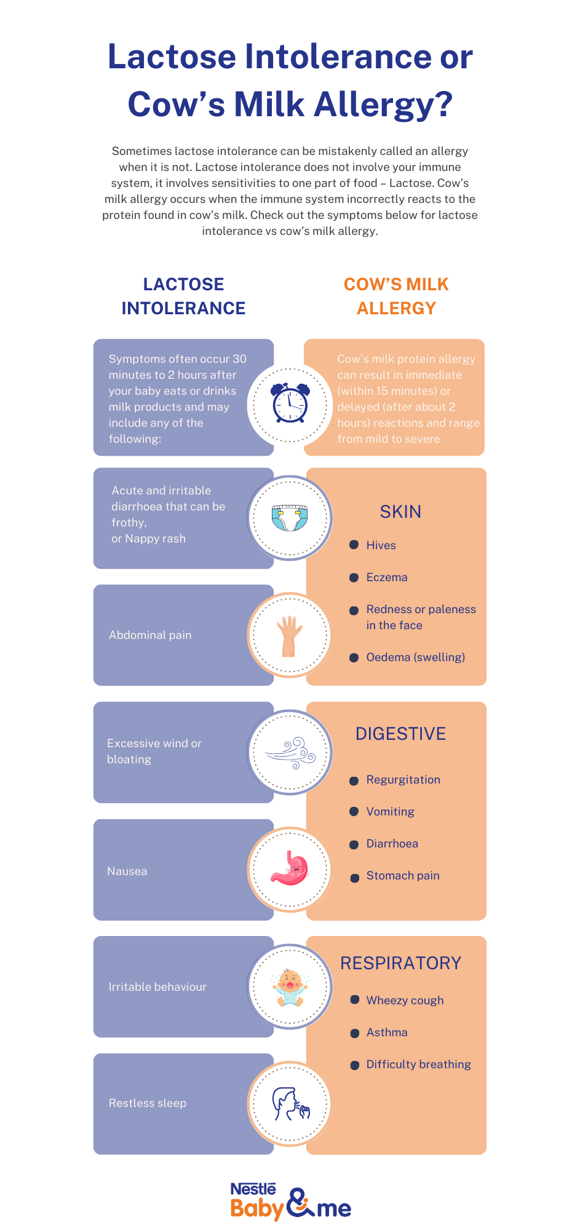What is lactose intolerance?
Lactose intolerance results from the intestine’s inability to digest lactose, the main carbohydrate, or sugar, found naturally in various animal milks (e.g. cow’s milk) and milk products. Lactose is also the main carbohydrate in breast milk.
Causes for lactose intolerance in babies
There are generally two causes of lactose intolerance in babies:
- Primary Lactose Intolerance in babies (alactasia): This inability to digest lactose is because the intestine does not make enough of the enzyme lactase, which is what is needed to digest and breakdown lactose. An extremely rare genetic condition which requires medical intervention.
- Secondary (Transient) Lactose Intolerance in babies: This is much more common. Short-term lactose intolerance in babies can develop when the small intestine cell lining is damaged, most commonly due to a bout of gastroenteritis. The cell lining is where the lactase enzyme lives; damage to these cells can mean an interruption and reduction of lactase activity. As the damage to the intestine lining recovers, so should the lactose intolerance. If symptoms continue you should see your doctor.
Lactose intolerance can also develop as your child grows older, if their lactase enzymes gradually start to decrease. This is genetically determined and quite common, about 70% of lactose intolerance after the age of five is this type (Lactase non-persistence, or hypolactasia).
What are the symptoms of lactose intolerance in babies?
Lactose intolerance symptoms in babies often occur 30 minutes to 2 hours after they eat or drink milk products and may include any of the following:
- Abdominal pain
- Acute and irritable diarrhoea that can be frothy
- Nausea
- Excessive wind
- Bloating
- Irritable behaviour
- Restless sleep
- Nappy rash
Often symptoms occur when your baby’s threshold to tolerate lactose has been passed. For example, often small amounts of lactose in yoghurt can be tolerated without any symptoms, however more dairy during that day may tip them over the edge, resulting in one or more symptoms.
With these very general symptoms, it can be difficult for parents to recognise lactose intolerance. It may be useful to keep a food diary and note down problem symptoms, but most importantly, see your healthcare professional for advice.
How is lactose intolerance in babies diagnosed?
Lactose intolerance is usually diagnosed through a lactose challenge, where you consume a large amount of lactose to observe how your body reacts. Since a baby’s diet consists predominantly of lactose containing milk (breast milk, or infant formula) this challenge has already been done. For a formula-fed lactose intolerant baby with a transient intolerance, a doctor may suggest removing lactose from the diet and monitoring for improvement in their symptoms. For a breastfed infant, it's important to work closely with your doctor to understand the symptoms your little one is experiencing and find the best approach for managing their intolerance.
Other tests, like the hydrogen breath test, blood glucose test, lactose intolerance genetic test, and small bowel biopsy, are available but may not definitively prove lactose intolerance, and may not be the best option for young babies.
Will my baby get over a lactose intolerance?
Lactose intolerance in babies can sometimes be temporary and resolve on its own as their digestive system matures. However, it depends on the underlying cause of the intolerance. If it is due to a temporary condition, such as a bout of ‘gastro’, it will likely resolve as they recover from the gastro. In cases where lactose intolerance is caused by a deficiency of the enzyme lactase, it may persist into adulthood. It's best to consult with your medical professional for a proper diagnosis and guidance on managing your baby's lactose intolerance. They can provide personalised advice based on your baby's specific needs.
How is lactose intolerance managed?
Simply put, you avoid or reduce lactose in the diet. However, it’s not quite as simple as that. Once a doctor diagnoses lactose intolerance, it’s worth seeing a dietitian for tailored dietary advice as the amount of lactose that can be tolerated will vary from baby to baby.
If your baby is breastfeeding, continue breastfeeding where possible, unless otherwise advised by your doctor. For the management of primary lactose intolerance (which is very rare), it is recommended you get guidance from a medical professional and dietitian. For some, it is possible to express breast milk and use lactase tablets to break down the lactose. However, it may not always be straight forward and for individualised care you should talk to your medical professional.
If your baby is formula feeding, your doctor may recommend changing to a lactose intolerant baby formula that is specially designed for baby lactose intolerance.
If your baby is older and has started solid food, there are a range of lactose free or low lactose milk and milk products available. Dairy products are a great source of calcium, which is important for your baby’s bones and teeth. If you are concerned your baby may be lactose intolerant, consult the expertise of a dietitian or other healthcare professional.
Lactose Intolerance or Cow’s Milk Allergy?
Sometimes lactose intolerance can be mistakenly called an allergy when it is not. Lactose intolerance does not involve your immune system, it involves sensitivities to one part of food – Lactose – and causes reactions in the digestive system, which is still maturing in infants and young children. Symptoms of lactose intolerance are most often less severe than symptoms associated with a cow’s milk allergy.

FAQs
Is breast milk lactose free?
No, breast milk is not lactose free. Breast milk naturally contains lactose and it is the main carbohydrate or sugar found in milk. Most babies are able to tolerate and digest lactose in breast milk without any issues. Lactose is important for providing your baby with energy. The amount of lactose in breast milk is consistent and is not influenced by what the mother eats, so it is not necessary for the mum to change her diet or exclude dairy. In rare cases, babies with primary lactose intolerance will require medical advice for the best feeding option.
How to know if my newborn is lactose intolerant?
If you suspect your baby may be lactose intolerant, it is important to consult with a healthcare professional for proper diagnosis and guidance. One of the most common symptoms of lactose intolerance in babies is diarrhoea. Diarrhoea can be dehydrating and very dangerous for newborn babies if it is not addressed early. Other symptoms of lactose intolerance in babies may include abdominal pain, irritable behaviour, restless sleep or nappy rash.
What is lactose intolerance formula?
Specialised infant formula is sold in Australia and New Zealand for formula-fed infants experiencing symptoms of lactose intolerance. These infant formulas meet all the nutritional needs of an infant to support healthy growth and development. From 6 months of age infants will need additional nourishment from solid foods. For primary lactose intolerance, a formula-fed baby will stay on this formula until 1 year of age. For babies with secondary lactose intolerance, these formulas are intended for short term use, under medical supervision, and once symptoms resolve it is recommended to transition back to an every-day infant formula.
Can newborns be lactose intolerant?
Yes, newborns can be lactose intolerant, however most newborns can tolerate lactose in breast milk or formula. A very small number of infants are born without the ability to produce lactase - the enzyme needed to digest lactose. The more common form of lactose intolerance is transient lactose intolerance, meaning it’s only temporary. Transient lactose intolerance occurs when the small intestine cell lining is damaged and recovering, often due to a bout of gastroenteritis. If you suspect your newborn may be lactose intolerant, it is important to consult with a healthcare professional for proper diagnosis and guidance.
Are all babies lactose intolerant?
No, not all babies are lactose intolerant, in fact it’s very rare. Most babies are born with the ability to produce lactase and can digest lactose without any issues. The breast milk carbohydrate source is predominantly lactose, a naturally occurring milk sugar, important for providing your baby with energy.
Sources:
- Health Direct website, accessed at https://www.healthdirect.gov.au/lactose-intolerance



